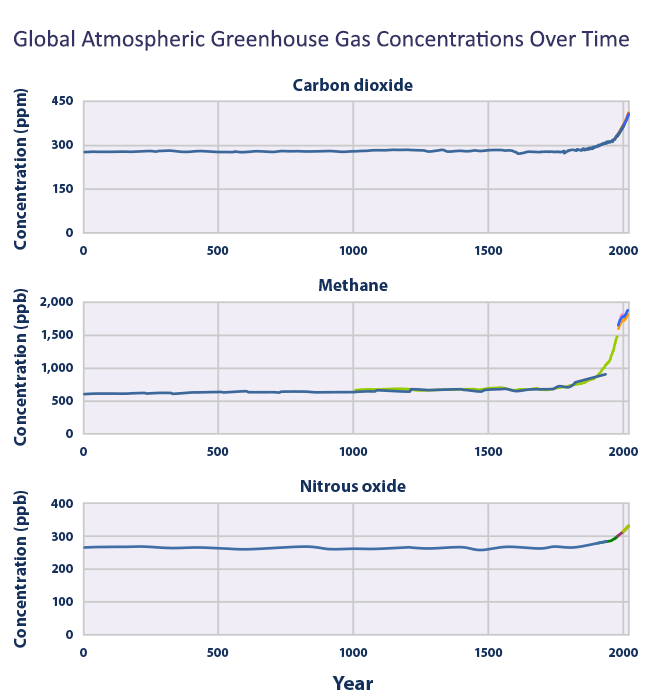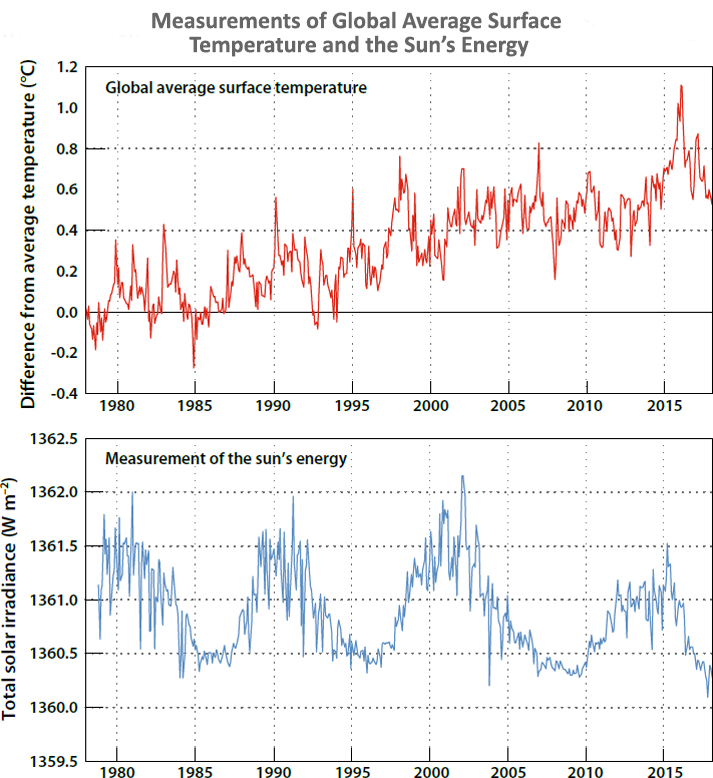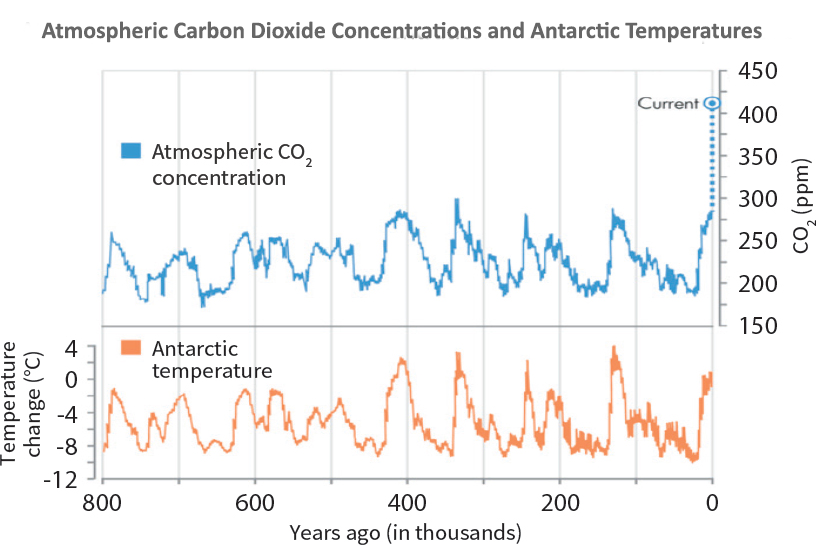Is Climate Change Real And Human Caused?
Since the Industrial Revolution, homo activities have released large amounts of carbon dioxide and other greenhouse gases into the atmosphere, which has changed the earth'southward climate. Natural processes, such as changes in the lord's day's energy and volcanic eruptions, besides bear upon the globe'due south climate. However, they practise not explain the warming that we have observed over the last century.1
Human being Versus Natural Causes
Scientists accept pieced together a record of the earth's climate by analyzing a number of indirect measures of climate, such as ice cores, tree rings, glacier lengths, pollen remains, and ocean sediments, and by studying changes in the earth's orbit around the sun.ii This record shows that the climate varies naturally over a broad range of time scales, but this variability does non explain the observed warming since the 1950s. Rather, it is extremely likely (> 95%) that human activities take been the dominant crusade of that warming.three
Human activities have contributed substantially to climatic change through:
- Greenhouse Gas Emissions
- Reflectivity or Absorption of the Sun'south Energy
Rut-trapping Greenhouse Gases And The Earth's Climate
Source: Smithsonian National Museum of Natural History, 2018
Greenhouse Gases
Concentrations of the key greenhouse gases have all increased since the Industrial Revolution due to human activities. Carbon dioxide, methane, and nitrous oxide concentrations are now more abundant in the earth'due south temper than any time in the last 800,000 years.5 These greenhouse gas emissions take increased the greenhouse result and caused the earth'due south surface temperature to rise. Burning fossil fuels changes the climate more than than whatsoever other human activity.
Carbon dioxide: Human being activities currently release over xxx billion tons of carbon dioxide into the temper every year.6 Atmospheric carbon dioxide concentrations have increased past more than forty percent since pre-industrial times, from approximately 280 parts per meg (ppm) in the 18th century7 to 414 ppm in 2020.8
Methane: Human activities increased methyl hydride concentrations during most of the 20th century to more than 2.five times the pre-industrial level, from approximately 722 parts per billion (ppb) in the 18th century9 to 1,867 ppb in 2019.10
Nitrous oxide: Nitrous oxide concentrations accept risen approximately 20 percentage since the start of the Industrial Revolution, with a relatively rapid increase toward the stop of the 20th century. Nitrous oxide concentrations take increased from a pre-industrial level of 270 ppb11 to 332 ppb in 2019.12
For more information on greenhouse gas emissions, see the Greenhouse Gas Emissions website. To larn more virtually deportment that tin can reduce these emissions, see What You Can Do.

Reflectivity or Absorption of the Sun's Energy
Activities such as agriculture, route construction, and deforestation can change the reflectivity of the world's surface, leading to local warming or cooling. This effect is observed in heat islands, which are urban centers that are warmer than the surrounding, less populated areas. I reason that these areas are warmer is that buildings, pavement, and roofs tend to reflect less sunlight than natural surfaces. While deforestation tin can increase the earth'south reflectivity globally past replacing dark copse with lighter surfaces such as crops, the net effect of all land-use changes appears to be a modest cooling.thirteen
Emissions of pocket-size particles, known every bit aerosols, into the air tin can likewise lead to reflection or absorption of the sun's energy. Many types of air pollutants undergo chemic reactions in the atmosphere to create aerosols. Overall, human-generated aerosols have a internet cooling effect on the earth. Acquire more than about human-generated and natural aerosols.
Natural Processes
Natural processes are ever influencing the earth's climate and can explain climate changes prior to the Industrial Revolution in the 1700s. However, recent climate changes cannot exist explained by natural causes solitary.
Changes in the Earth'due south Orbit and Rotation
Changes in the earth's orbit and its centrality of rotation have had a big impact on climate in the past. For example, the amount of summer sunshine on the Northern Hemisphere, which is afflicted by changes in the planet's orbit, appears to exist the master cause of past cycles of ice ages, in which the earth has experienced long periods of common cold temperatures (ice ages), too as shorter interglacial periods (periods between water ice ages) of relatively warmer temperatures.xiv At the coldest part of the last glacial flow (or ice historic period), the average global temperature was near 11°F colder than information technology is today. At the top of the last interglacial menstruum, however, the average global temperature was at most 2°F warmer than it is today.15
Variations in Solar Activity
Changes in the sun's energy output tin bear upon the intensity of the sunlight that reaches the globe'due south surface. While these changes tin influence the earth's climate, solar variations have played footling function in the climate changes observed in recent decades.xvi Satellites have been measuring the amount of free energy the world receives from the sun since 1978. These measurements testify no net increase in the sun'southward output, even as global surface temperatures have risen.17

Changes in the Earth'southward Reflectivity
The amount of sunlight that is absorbed or reflected by the planet depends on the globe'due south surface and atmosphere. Dark objects and surfaces, like the sea, forests, and soil, tend to blot more sunlight. Light-colored objects and surfaces, similar snowfall and clouds, tend to reflect sunlight. Almost 70 percent of the sunlight that reaches the earth is absorbed.18 Natural changes in the earth's surface, similar the melting of sea ice, have contributed to climatic change in the past, oft acting equally feedbacks to other processes.
Volcanic Action
Volcanoes have played a noticeable role in climate, and volcanic eruptions released large quantities of carbon dioxide in the distant past. Some explosive volcano eruptions tin throw particles (east.k., And then2) into the upper temper, where they tin reflect enough sunlight back to space to absurd the surface of the planet for several years.19 These particles are an instance of cooling aerosols.
Volcanic particles from a single eruption do not produce long-term climate modify because they remain in the atmosphere for a much shorter fourth dimension than greenhouse gases. In addition, human activities emit more than 100 times equally much carbon dioxide as volcanoes each year.xx
Changes in Naturally Occurring Carbon Dioxide Concentrations
Over the final several hundred thousand years, carbon dioxide levels varied in tandem with the glacial cycles. During warm interglacial periods, carbon dioxide levels were higher. During absurd glacial periods, carbon dioxide levels were lower.21 The heating or cooling of the earth's surface and oceans tin cause changes in the natural sources and sinks of these gases, and thus change greenhouse gas concentrations in the atmosphere.22 These changing concentrations have acted as a positive climate feedback, amplifying the temperature changes caused by long-term shifts in the earth'due south orbit.23

1 National University of Sciences. (2020). Climate alter: Bear witness and causes: Update 2020. The National Academies Press, Washington, DC, p. five. doi: ten.17226/25733
2Wuebbles, D.J., D.Westward. Fahey, Thou.A. Hibbard, B. DeAngelo, S. Doherty, K. Hayhoe, R. Horton, J.P. Kossin, P.C. Taylor, A.Yard. Waple & C.P. Weaver. (2017). Executive summary. In: Climate science special report: 4th national climate cess, volume I [Wuebbles, D.J., D.W. Fahey, G.A. Hibbard, D.J. Dokken, B.C. Stewart & T.Thousand. Maycock (eds.)]. U.Southward. Global Change Research Program, Washington, DC, pp. 12–34, doi: 10.7930/J0DJ5CTG
National University of Sciences. (2020). Climate change: Show and causes: Update 2020. The National Academies Press, Washington, DC, p. 5. doi: 10.17226/25733
threeIPCC (2013). Climatic change 2013: The physical scientific discipline basis.Working Grouping I contribution to the 5th cess written report of the Intergovernmental Console on Climate Change [Stocker, T.F., D. Qin, G.-K. Plattner, M. Tignor, S.K. Allen, J. Boschung, A. Nauels, Y. Xia, V. Bex & P.M. Midgley (eds.)]. Cambridge University Printing, Cambridge, United Kingdom and New York, NY, p. 869.
ivIPCC. (2021). Climate change 2021: The physical scientific discipline ground. Working Group I contribution to the 6th assessment report of the Intergovernmental Console on Climate Change [Masson-Delmotte, 5., P. Zhai, A. Pirani, Due south.L. Connors, C. Péan, Southward. Berger, N. Caud, Y. Chen, L. Goldfarb, M.I. Gomis, M. Huang, Thousand. Leitzell, Due east. Lonnoy, J.B.R. Matthews, T.K. Maycock, T. Waterfield, O. Yelekçi, R. Yu & B. Zhou (eds.)]. Cambridge Academy Press, Cambridge, United Kingdom, p. SPM-5.
5National University of Sciences. (2020). Climate change: Testify and causes: Update 2020. The National Academies Press, Washington, DC, p. B-2. doi: 10.17226/25733
Fahey, D.Due west., S.J. Doherty, Thousand.A. Hibbard, A. Romanou & P.C. Taylor. (2017).Physical drivers of climate alter. In: Climate science special report: Fourth national climate cess, volume I [Wuebbles, D.J., D.W. Fahey, M.A. Hibbard, D.J. Dokken, B.C. Stewart & T.Grand. Maycock (eds.)]. U.S. Global Change Research Program, Washington, DC, p. fourscore, Figure 2.iv. doi: ten.7930/J0513WCR
sixHayhoe, K., D.J. Wuebbles, D.R. Easterling, D.Due west. Fahey, Due south. Doherty, J. Kossin, W. Sweet, R. Vose & M. Wehner. (2018). Our irresolute climate. In: Impacts, risks, and adaptation in the United States: 4th national climate assessment, book II [Reidmiller, D.R., C.W. Avery, D.R. Easterling, G.E. Kunkel, K.L.M. Lewis, T.K. Maycock & B.C. Stewart (eds.)]. U.S. Global Modify Research Program, Washington, DC, p. 76. doi: ten.7930/NCA4.2018
7IPCC. (2013). Climate change 2013: The physical science footing.Working Group I contribution to the fifth assessment study of the Intergovernmental Panel on Climate change [Stocker, T.F., D. Qin, G.-G. Plattner, One thousand. Tignor, South.K. Allen, J. Boschung, A. Nauels, Y. Xia, V. Bex & P.G. Midgley (eds.)]. Cambridge University Press, Cambridge, United Kingdom, and New York, NY, p. 166.
8 NOAA. (2021). Trends in atmospheric carbon dioxide. Retrieved 3/25/2021. esrl.noaa.gov/gmd/ccgg/trends/mlo.html
9 IPCC. (2013).Climate modify 2013: The physical science basis.Working Group I contribution to the fifth assessment report of the Intergovernmental Panel on Climate Alter [Stocker, T.F., D. Qin, G.-K. Plattner, Yard. Tignor, South.K. Allen, J. Boschung, A. Nauels, Y. Xia, Five. Bex & P.K. Midgley (eds.)]. Cambridge Academy Press, Cambridge, United Kingdom, and New York, NY, p. 167.
10 NOAA. (2021). Trends in atmospheric marsh gas. Retrieved iii/25/2021. esrl.noaa.gov/gmd/ccgg/trends_ch4
11 IPCC. (2013).Climate change 2013: The physical science ground.Working Group I contribution to the fifth cess report of the Intergovernmental Panel on Climatic change [Stocker, T.F., D. Qin, M.-G. Plattner, M. Tignor, S.K. Allen, J. Boschung, A. Nauels, Y. Xia, V. Bex & P.M. Midgley (eds.)]. Cambridge Academy Printing, Cambridge, United Kingdom, and New York, NY, p. 168.
12 NOAA. (2021). Trends in nitrous oxide. Retrieved 3/25/2021. esrl.noaa.gov/gmd/ccgg/trends_n2o/
13 Fahey, D.Due west., Due south.J. Doherty, M.A. Hibbard, A. Romanou & P.C. Taylor. (2017). Physical drivers of climate alter. In: Climate scientific discipline special written report: Fourth national climate assessment, volume I [Wuebbles, D.J., D.W. Fahey, K.A. Hibbard, D.J. Dokken, B.C. Stewart & T.1000. Maycock (eds.)]. U.South. Global Change Research Program, Washington, DC, p. 78, Fig. 2.three and p. 86. doi: ten.7930/J0513WCR
14 National Academy of Sciences. (2020). Climate change: Show and causes: Update 2020. The National Academies Press, Washington, DC, p. 9. doi: ten.17226/25733
15 Fahey, D.W., S.J. Doherty, Yard.A. Hibbard, A. Romanou & P.C. Taylor. (2017). Our globally changing climate. In: Climate science special report: Fourth national climate assessment, volume I [Wuebbles, D.J., D.Westward. Fahey, M.A. Hibbard, D.J. Dokken, B.C. Stewart & T.K. Maycock (eds.)]. U.S. Global Modify Enquiry Program, Washington, DC, p. 53. doi: x.7930/J08S4N35
16 National University of Sciences. (2020). Climatic change: Evidence and causes: Update 2020. The National Academies Press, Washington, DC, p. 7. doi: 10.17226/25733
17 National University of Sciences. (2020). Climate change: Testify and causes: Update 2020. The National Academies Press, Washington, DC, p. 7. doi: 10.17226/25733
eighteen Fahey, D.W., S.J. Doherty, Thou.A. Hibbard, A. Romanou, & P.C. Taylor. (2017). Concrete drivers of climatic change. In: Climate science special report: Fourth national climate assessment, book I [Wuebbles, D.J., D.West. Fahey, K.A. Hibbard, D.J. Dokken, B.C. Stewart & T.M. Maycock (eds.)]. U.S. Global Change Research Programme, Washington, DC, p. 2. doi: x.7930/J0513WCR
19 Fahey, D.W., S.J. Doherty, K.A. Hibbard, A. Romanou, & P.C. Taylor. (2017). Physical drivers of climate change. In: Climate science special study: Fourth national climate assessment, volume I [Wuebbles, D.J., D.W. Fahey, K.A. Hibbard, D.J. Dokken, B.C. Stewart & T.M. Maycock (eds.)]. U.South. Global Change Research Program, Washington, DC, p. 79. doi: 10.7930/J0513WCR
20 Fahey, D.W., Southward.J. Doherty, K.A. Hibbard, A. Romanou & P.C. Taylor. (2017). Physical drivers of climate alter. In: Climate scientific discipline special study: Fourth national climate assessment, volume I [Wuebbles, D.J., D.W. Fahey, Yard.A. Hibbard, D.J. Dokken, B.C. Stewart & T.Grand. Maycock (eds.)]. U.Southward. Global Change Research Programme, Washington, DC, p. 79. doi: x.7930/J0513WCR
21 National Academy of Sciences. (2020). Climate alter: Show and causes: Update 2020. The National Academies Press, Washington, DC, pp. 9–10. doi: 10.17226/25733
22 IPCC. (2013).Climate alter 2013: The physical scientific discipline basis.Working Group I contribution to the 5th assessment report of the Intergovernmental Panel on Climatic change [Stocker, T.F., D. Qin, Thousand.-Grand. Plattner, M. Tignor, Due south.K. Allen, J. Boschung, A. Nauels, Y. Xia, 5. Bex & P.M. Midgley (eds.)]. Cambridge Academy Press, Cambridge, United Kingdom and New York, NY, p. 399.
23 National Academy of Sciences. (2020). Climate change: Evidence and causes: Update 2020. The National Academies Printing, Washington, DC, pp. 9–10. doi: x.17226/25733
Source: https://www.epa.gov/climatechange-science/causes-climate-change
Posted by: barnesweng1974.blogspot.com

0 Response to "Is Climate Change Real And Human Caused?"
Post a Comment